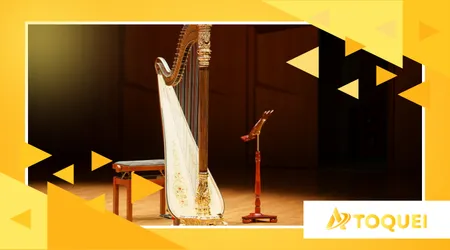What is a Celtic harp and how does it differ from a classical harp?

What is a Celtic harp? And how does it differ from the imposing classical harp found in large orchestras?
Advertisements
This article sheds light on the characteristics, function, and cultural legacy that separate these two magnificent instruments, revealing their specificities and the context in which they shine.
Prepare yourself for a sonic journey that transcends centuries and distinct musical styles.
The Celtic harp, also often called the folk or Irish harp, is a profound symbol of nations like Ireland, where it appears on the national coat of arms and currency.
Its form dates back to the ancient musical traditions of Europe, being the primary choice of bards and troubadours.
Advertisements
This instrument typically has a smaller number of strings, ranging from 24 to 38, and is noticeably lighter and more portable.
Its sound is generally sweeter, clearer, and with a faster resonance.
How does the Celtic Harp work without the pedals?

The absence of pedals is the fundamental characteristic that distinguishes the instrument from its orchestral relatives.
Instead of complex double-action pedal mechanisms, the Celtic harp uses levers, known as levers.
These small keys are fixed to the top of the column, near the tuning pegs, and allow the musician to raise the pitch of a string by a semitone.
The harpooner needs to manually operate the levers to change accidents and modulate, limiting rapid modulations.
What defines a classical harp or a concert harp?
The classical harp, on the other hand, is a colossus of engineering and sound, designed specifically for the vast orchestral repertoire and for classical recitals.
++Trumpet for beginners: a guide to affordable brands and models.
It is a large, heavy, and extremely robust instrument, designed to generate a sound volume capable of standing out in a symphonic ensemble.
Featuring 47 strings, this concert harp encompasses an impressive tonal range, crucial for the great works of composers such as Debussy and Ravel.
What are the functions of the pedals on a classical harp and what are their advantages?

The pedals are the technical heart of the classical harp and constitute its greatest musical advantage.
Seven double-action pedals, one for each note of the scale (C, D, E, F, G, A, B), allow the harpist to change the tuning of all the strings of a specific note in three positions: flat, natural, and sharp.
Learn more: How the pipe organ works and its sound complexity
This technology gives the concert harp unparalleled harmonic flexibility, enabling rapid transitions between keys and the performance of highly chromatic pieces.
Why are size and weight crucial differences?
Structural disparities directly impact the use and portability of each instrument.
A classical harp, due to its robust body and pedal mechanism, can weigh over 35 kg and measure approximately 1.85 meters in height.
In contrast, a professional Celtic harp, even with 38 strings, rarely exceeds 15 kg and 1.60 meters in length, making it ideal for travel and more intimate solo performances.
See how interesting: The origin and sound of the Indian sitar
This difference in weight and volume is analogous to comparing a violin, which is easily transportable, to a cello, which requires more logistics.
What types of strings and timbre are expected in each harp?
The choice of string material is responsible for the clear distinction in timbre.
Traditional Irish Celtic harps were often fitted with metal strings (brass or bronze), resulting in a resonant, metallic sound, with a decay longer.
See how interesting: What is the difference between a Celtic harp and a symphonic harp?
However, modern Celtic harps more commonly use nylon or synthetic gut strings.
The classical harp primarily uses animal or synthetic gut for the middle and high notes, and steel wrapped in nylon string for the low notes, delivering a more rounded timbre.
How does Celtic music benefit from the sound of the lever harp?
The sound of the Celtic harp is intrinsically linked to folk and traditional music, where melodic agility and clarity of timbre are essential.
Tuning in a specific mode, without the need for complex modulations, favors the style of Celtic melodies and dances.
An example of this is the use of the Celtic harp in an Irish music session, playing... jigs and reels with quick embellishments and a steady rhythm.
The classical harp, with its rich sound, would hardly achieve the same authenticity in this context.
What is a Celtic harp and what is the cultural significance of the classical harp?
The classical harp, also called the orchestral harp, symbolizes the sophistication of classical music and the pinnacle of the instrument's technical evolution in the West.
She is the standard for performance in large theaters and concert halls.
However, it is vital to emphasize that What is a Celtic harp? It transcends the realm of classical music, carrying with it the weight of the cultural identity and history of the Celtic peoples.
Does the choice of repertoire determine the correct harp?
Yes, the repertoire undeniably determines which harp will be the appropriate choice for the musician.
Complex orchestral pieces, which require rapid tonal modulations and intense chromaticism, demand the pedal harp, as it can alter the tuning of the entire scale in an instant.
On the other hand, for the performance of arrangements of folk songs, medieval music, or for the exploration of repertoires by contemporary composers focused on folk sounds, What is a Celtic harp? It's the ideal tool.
| Feature | Celtic Harp (Lever) | Classical Harp (Pedal) |
| Mechanism | Levers (Leverssemitone | Dual Action Pedals |
| Strings (Medium) | 24 to 38 strings | 47 strings |
| Rope Material | Nylon, Synthetic Gut or Metal | Animal/Synthetic Casing and Steel |
| Approximate Weight | 5 kg to 15 kg | 35 kg to 45 kg |
| Main Function | Folk Music, Solo, Accompaniment | Orchestral and Classical Music |
| Modulation Capability | Limited edition, manual (semitons) | Complete, fast (tones and semitones) |
How does the Celtic Harp fit into the current musical landscape (2025)?
Currently, the Celtic harp enjoys renewed popularity, driven by genres that seek more organic and intimate sounds.
Contemporary musicians incorporate it into film soundtracks and productions of... new age, and even in collaborations with pop and rock artists.
The instrument's versatility and portability are attracting a new generation of harpists.
It's a remarkable rise, far from being just a niche cultural tool.
What is a Celtic harp: Conclusion
Although both are harps and share the undeniable beauty of plucked sound, the Celtic harp and the classical harp represent completely distinct musical philosophies and engineering.
One remains true to folk tradition with its mobility and simple mechanical levers, while the other has reached the pinnacle of chromatic complexity with its pedal system.
Understanding the differences between them is to appreciate the rich tapestry of music history and the continuous evolution of organology.
Frequently Asked Questions
Which harp is easiest for a beginner to learn?
The Celtic harp, or lever harp, is generally recommended for beginners due to its smaller number of strings and the absence of complex pedal coordination. The initial cost of a Celtic study model is also usually significantly lower.
Is it possible to play classical music on a Celtic harp?
Yes, it is possible to play a simplified or arranged classical repertoire, but pieces that rely on rapid tonal modulations and simultaneous chromatic accidentals will be extremely difficult or impossible to perform faithfully due to the limitations of the whammy bars.
Where is the Celtic harp most commonly used today?
The Celtic harp is predominant in Irish, Scottish, and Breton folk and traditional music, in chamber music groups. new age, It is very popular for music therapy and education due to its portability.
